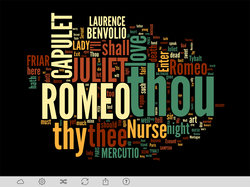
1. Text Summaries- The most important ideas should be predominate, helping students focus on the main idea and eliminating nonessential details when writing a text summary.
2. Pre-Reading Strategies- A word cloud can help students focus on new vocabulary that may be introduced or make predictions regarding an upcoming text.
3. Writing Revision- By pasting their own work into the program students look for repetition cropping up in their writing.
4. Text Analysis- Examining a word cloud on a text or website can lead to important questions about the writing. What is the theme, message, or mood of this text? Can we determine any bias the author may have? What does the author chose to emphasize and why do you think that is? How does the language of a work determine these factors? Imagine a word cloud on the declaration of independence or the first chapter of a novel.
5. Group Brainstorming- Each group member must contribute a word to program and duplication is allowed. Projects in which each member uses an adjective to describe an individual can produce interesting results for historical figures, literary characters, or classmates. Similarly, historical or current events, scientific processes, mathematical premises, or any type of academic content can be used in a group brainstorming session.
Examples of free word cloud programs include: Wordle, Tagxedo, and Word Clouds.
-Michelle Bothel

 RSS Feed
RSS Feed
